Does Corn Seed Orientation in the Furrow Matter?

Crop Insights
Written by Mark Jeschke, Ph.D., Agronomy Manager
Crop Insights
Written by Mark Jeschke, Ph.D., Agronomy Manager
Agronomists and corn producers have long been interested in the potential to improve corn growth and yield by controlling the orientation of the corn seed in the furrow at planting, with research on this question dating back to at least the 1950s (Peters and Woolley, 1959). The goal of this research has been to determine if controlling the orientation of planted seeds can help optimize early root and shoot growth and the orientation of the plant’s leaves.
Despite ongoing interest in the potential value of uniform seed orientation, the total body of research on the topic remains relatively sparse and results over the years have been mixed. The need to precisely control the orientation of each seed and the lack of a mechanized means to do so has meant that research on this topic has generally been difficult and labor-intensive. The lack of any commercially available planter technology capable of controlling seed orientation has likely also limited the degree of urgency in researching seed orientation – even it was shown to matter, growers would have no way of doing anything about it.
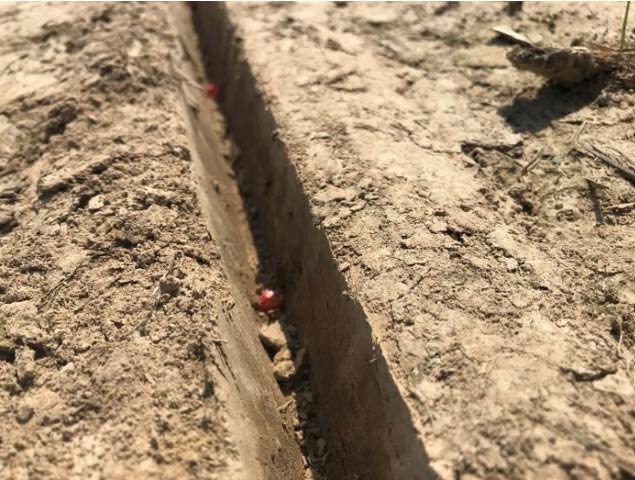
The potential value of corn seed orientation remains a subject of interest today for a couple of key reasons. First, although there is not yet a planter unit on the market capable of controlling corn seed orientation, planter technology overall has advanced considerably over the past few decades. With the development of planting technologies such as John Deere ExactEmerge™ and Precision Planting SpeedTube® that maintain control of the seed from the meter until it is deposited in the furrow, manipulating seed orientation seems like much less of a leap in technology than it would have been 60 years ago when the first research into the question was being conducted. Second, changes in agronomic practices such as higher plant densities and earlier planting could make any advantages in emergence uniformity or crop canopy structure attainable through uniform seed orientation more important than they might have been in the past.
Germination and Emergence
The reason that corn seed orientation could potentially influence corn growth and yield has to do with how the initial growth from the germinating seed occurs. The radicle root emerges near the tip of the kernel and the coleoptile emerges from the embryo side of the kernel and elongates in the opposite direction toward the dent end of the kernel (Figure 1).

Figure 1. Diagram of a corn kernel showing components of the embryo and a germinated corn seed showing the emerging coleoptile and radicle.
When a corn kernel planted with the tip pointed downward, the emerging radicle and coleoptile are pointed in the direction they need to grow, without the need for the seedling to expend additional energy and time to bend their growth downward and upward, respectively (Figure 2). Corn seeds planted uniformly with the kernel tips pointed downward could potentially lead to quicker and more uniform emergence.

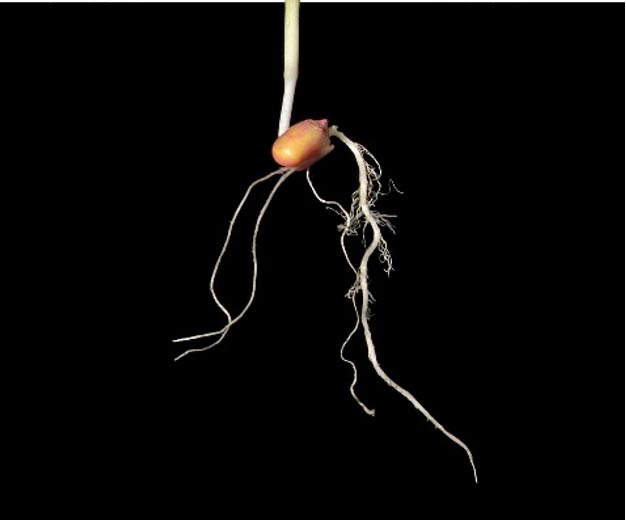
Figure 2. Corn seedling that was planted with the kernel tip angled upward, showing how both the coleoptile and radicle had to bend as they elongated to grow in the proper direction.
The orientation of the corn seed in the furrow can also influence the orientation of the plant’s leaves. Corn is a distichous plant, meaning that its leaves are arranged alternately on opposite sides of the stem, with the total leaf area of the plant contained largely within the same vertical plane. The standard practice of planting corn in rows – most commonly spaced 30 inches (76 cm) apart in North American corn production – means that a plant will be in much closer proximity to its neighbors within the row than to plants in adjacent rows. Preferentially orienting the plane of corn leaf growth perpendicular to the rows, so that leaves extend into the interrow space could potentially improve sunlight capture by the corn canopy and reduce plant-to-plant competition for space and light within the row.
The orientation of the embryo (germ) side of the corn seed in the furrow has been shown to influence the orientation of the plant’s leaf growth (Fortin and Pierce, 1996). The plane of leaf growth tends to correspond to the direction of the germ. Consequently, seeds planted with the germ side perpendicular to the row will tend to have leaves oriented across the row rather than toward adjacent plants in the row (Figure 3).
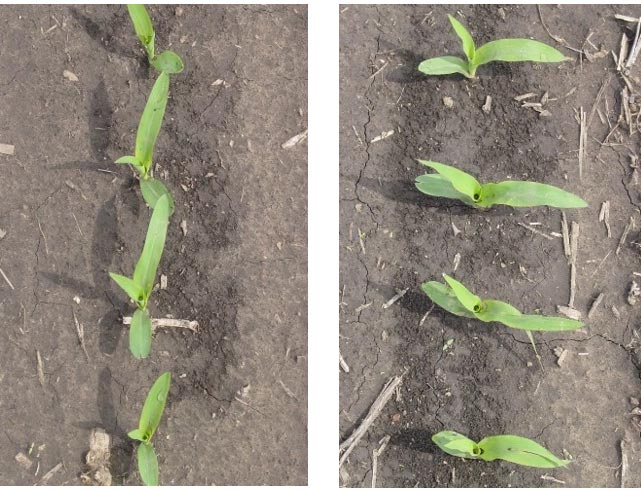
Figure 3. Corn plants in a Pioneer field experiment showing contrasting leaf orientation resulting from seeds planted tip down with the germ oriented with the row (left) and perpendicular to the row (right) (Paszkiewicz et al., 2005).
While this would seem to constitute a considerable advantage attainable through controlled seed orientation, the situation is complicated somewhat due to the inherent adaptability of corn plants during vegetative growth. Even though the orientation of the germ has a large impact on determining the orientation of the leaves, the plane of leaf growth is not completely fixed throughout the plant’s development. Research has shown that corn plants have some capacity to adjust their leaf orientation in response to their neighbors and redirect leaf growth toward the interrow space (Maddonni et al., 2002). A Pioneer field study found that this adjustment in leaf orientation occurs relatively early in the plant’s development – prior to the V6 growth stage (Jeschke and Uppena, 2015).
Maddonni et al. (2002) showed that adaptive ability can vary by hybrid. Of the two hybrids included in their study, one showed an increased proportion of leaves oriented toward the interrow and one did not. The extent to which this adaptive capacity varies among modern commercial hybrids is not known. Consequently, the amount and consistency of additional benefit to leaf orientation attainable through controlled seed orientation is not clear.
Several studies over the years have examined the effect of seed orientation on corn growth and yield. These studies have varied in the specific seed orientations tested, the methods employed in achieving desired orientations, additional factors included in the studies, and the outcomes that were measured.
Ohio State University (1967-1968) – One of the earliest studies on corn seed orientation was conducted in the 1960s at Ohio State University (Patten and Van Doren, 1970). This study compared seeds planted tip-down vs. tip-up but did not control for the orientation of the germ. Results showed that seeds planted tip-down achieved earlier and more complete emergence with more rapid seedling growth and were better able overcome stressful conditions during germination and emergence. However, despite favorable effects on emergence and early growth, seed orientation did not ultimately have a significant effect on yield.
Illinois State University (2011-2012) – At 2-year field study conducted by Illinois State University and partially supported through the Pioneer Crop Management Research Awards program compared yield of corn planted tip-down with the germ oriented with the row, tip-down with the germ oriented across the row, and randomly (Walker and Owens, 2013). Seed orientation significantly affected corn yield in both years of the study. Seeds planted tip-down, germ with the row outyielded randomly oriented seeds by 14%. Orienting the germ across the row increased yield by another 9% (Figure 4).
Observations of leaf orientation relative to the seed germ corresponded to those from previous research showing that initial leaf orientation is strongly correlated with germ orientation, but that leaf orientation can shift during vegetative growth. First leaves were oriented within 45° of the germ direction 89% or the time, whereas this was true of only 31% of ear leaves.

Figure 4. Seed orientation effects on corn yield in a 2-year Illinois State University field study (Walker and Owens, 2013).
Oklahoma State University (2010-2012) – An Oklahoma State University study compared the effect of several different seed orientations on plant leaf orientation in growth chamber studies (Torres et al., 2011). Results corresponded with those of previous research showing that certain seed orientations can have a strong effect on plant leaf orientation. Some seed orientations were also able to achieve faster emergence and a greater percentage of total emergence relative to randomly oriented seed. Field studies showed that controlled seed orientation improved light interception by the crop canopy and increased yield by 9 to 14% compared to randomly oriented seeds under irrigated production (Torres et al., 2017).
Iowa Seed Orientation Field Study (2002-2004) – A three-year Pioneer field study compared yield of corn planted tip-down with the germ oriented with the row, tip-down with the germ oriented across the row, and randomly (Paszkiewicz et al., 2005). This study also compared seed orientation effects across a wide range of plant populations, from 18,000 to 90,000 plants/acre. Field research was conducted in Johnston, IA in 2002, 2003, and 2004. A single hybrid was used each year of the study – one hybrid in 2002 and a different hybrid in 2003 and 2004.
Results of the study were mixed. Seed orientation significantly impacted corn yield in two out of three years of the study (2003 and 2004) and a significant seed orientation by plant population interaction was observed in 2003. Seed planted with the germ with the row was the highest yielding in 2003 and randomly oriented seed was highest yielding in 2004 (Figure 5). The yield advantage of the with-row germ orientation in 2003 was observed at higher plant populations (Figure 6).
These results were noteworthy because seed planted with the germ oriented across the row was not advantageous to yield in any year of the study. Based on the effects of seed orientation on leaf architecture, one would expect that orienting the germ across the row could be beneficial to light interception and yield and that this benefit would tend to increase at higher plant populations as competition between plants within the row intensified, but that is not what results showed. Leaf orientation and canopy light interception were not measured in the study, but observations indicate that leaf orientation of emerged plants was highly correlated with seed orientation (Figure 3) and that across the row germ orientation likely provided some benefit to canopy light interception, as least up through the mid-vegetative growth stages. However, these effects did not result in a yield advantage.
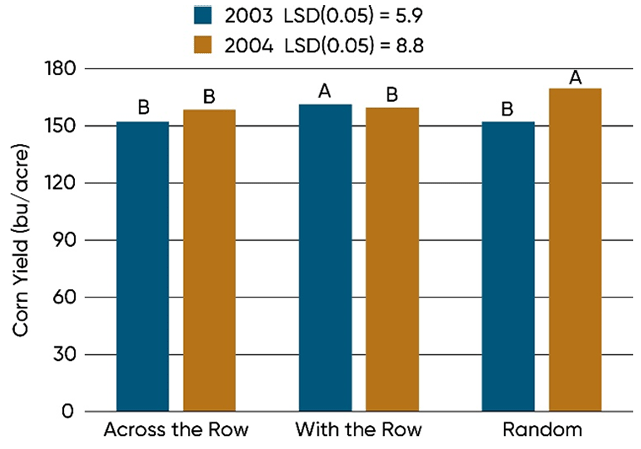
Figure 5. Seed orientation effects on corn yield in a 3-year Pioneer field study. Seed orientation effects were significant in two out of three years. Values with the same letter did not significantly differ within a year.
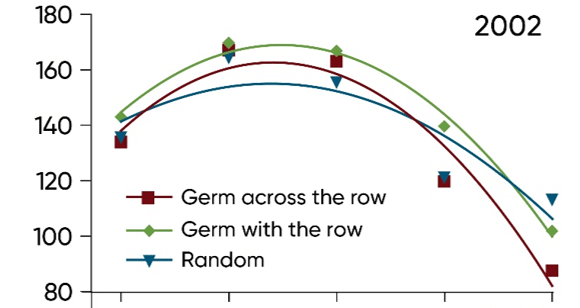
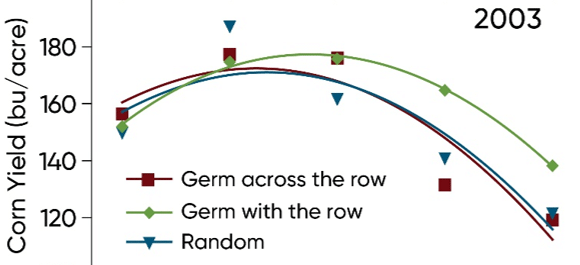
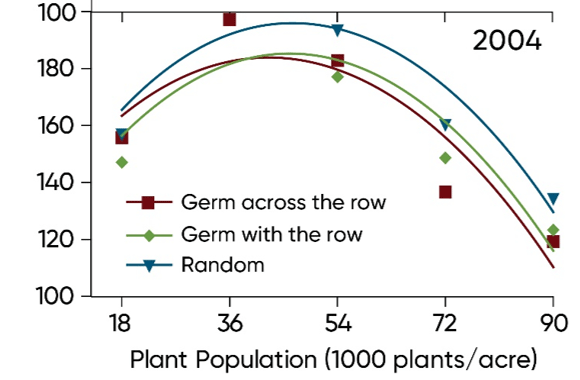
Figure 6. Corn yield response to seed orientation and plant population in a 3-year Pioneer field study (Paszkiewicz et al., 2005).
Iowa Leaf Orientation Field Studies (2013 and 2014) – Field studies were conducted in 2013 and 2014 at Johnston, IA to determine if corn plants would preferentially orient their leaves toward the interrow as observed by Maddonni et al. (2002). These studies did not involve controlling seed orientation – plots in the studies were planted using a normal 4-row research planter and measurements were taken during the season to determine if the plants altered their leaf orientation during vegetative growth. This question is relevant to seed orientation because if hybrids are consistently able to optimize their leaf orientation, it would tend to negate some of the potential benefits of controlled seed orientation.
The 2013 study included two hybrids planted at three populations – 30,000, 40,000, and 50,000 plants/acre. Leaf orientation measurements were taken on the 15th leaf in each treatment. Plant density did not have a significant effect on leaf orientation; however, a difference was observed between the two hybrids. Plants of one of the hybrids had a greater tendency to orient their leaves toward the interrow than plants of the other hybrid (Mesick and Jeschke, 2014).
The 2014 study used two different hybrids than those in the 2013 study. The hybrids in 2014 were chosen to represent contrasting leaf types based on previous research that showed one hybrid had a more upright leaf architecture than the other (Mesick and Jeschke, 2014). For the 2014 study, orientation measurements were taken on the 2nd, 6th, 10th, and 14th leaf to determine at what growth stage any observed changes in leaf orientation occurred. The 2014 study included the same three population densities as the 2013 study, which – once again – did not show a significant effect. Both hybrids in the 2014 study preferentially oriented their leaves toward the interrow and did so relatively early, with most of the adjustment occurring prior to the V6 growth stage (Jeschke and Uppena, 2015) (Figure 7).
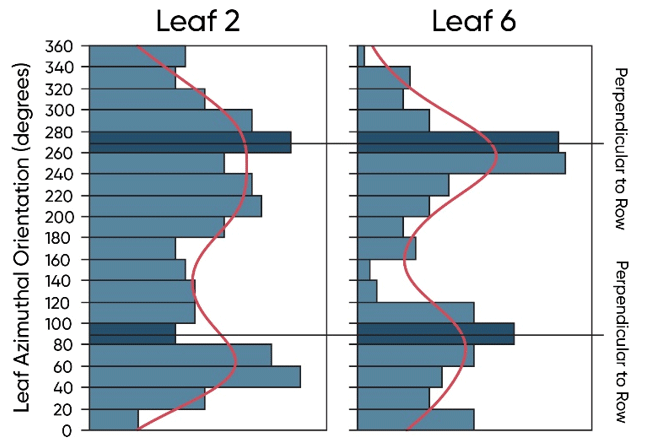
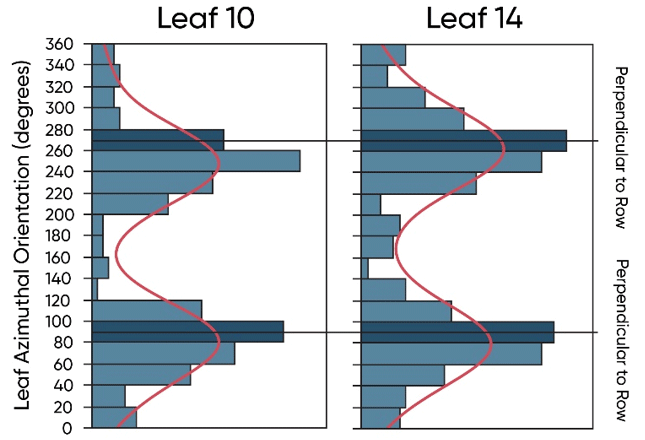
Figure 7. Distribution of azimuthal orientation for leaf 2, leaf 6, leaf 10, and leaf 14 averaged across corn products and population densities in a Pioneer field study (Jeschke and Uppena, 2015).
Indiana Seed Orientation Field Demonstration (2022) – A field demonstration was conducted in 2022 near Montgomery, Indiana to investigate the effects of corn seed orientation on speed of emergence, canopy closure, and light capture. The study compared four different seed orientations: tip down - germ across the row, tip up - germ with the row, tip down - germ with the row, and lying flat in the furrow. Time to emergence and canopy closure were recorded, as well as measurements of light capture and temperature under the canopy. Light capture was assessed by measuring the amount of light that was able to penetrate the canopy and reach ground level using an Apogee DLI-400 light meter.
Seeds planted with the tip down emerged faster than those planted tip up by approximately 20 GDUs (Emmert and Jeschke, 2022). Leaf orientation of seed planted tip down corresponded to the direction of the germ – seeds planted with germ oriented perpendicular to the row resulted in leaves growing across the row, while seeds planted with the germ parallel to the row resulted in leaves growing with the row (Figure 8). Interestingly, seeds planted with the tip up did not result in uniform leaf orientation, even though the germ orientation was uniform. This is likely due to the circuitous path the coleoptile had to take around the kernel as it emerged.
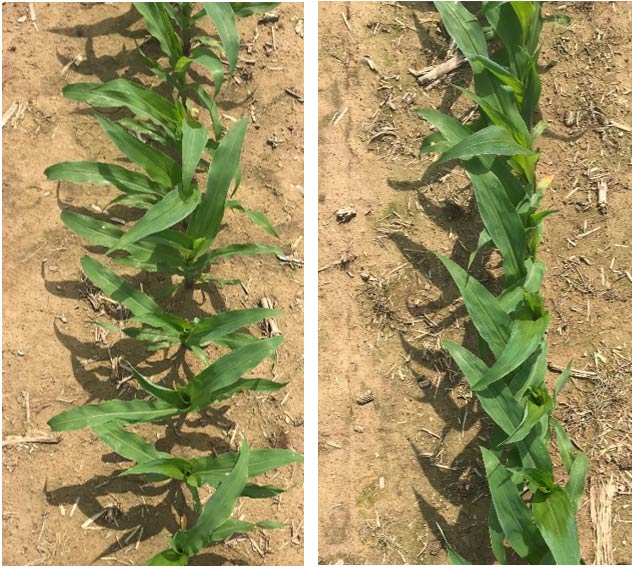
Figure 8. Corn plants from seeds planted tip down with the germ oriented across the row (left) and with the row (right) showing the impact of germ direction of leaf orientation during early vegetative growth.
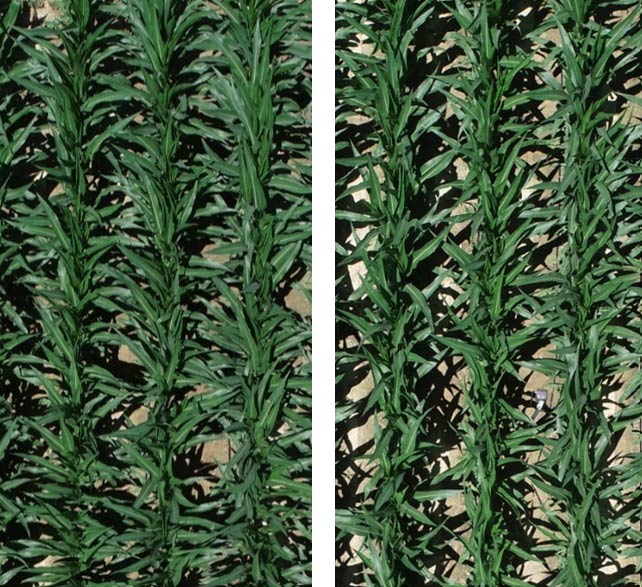
Figure 9. Corn plants from seeds planted tip down with the germ oriented across the row (left) and with the row (right) showing the impact of germ direction of leaf orientation during later vegetative growth.
Seeds planted with the tip down and germ perpendicular to the row resulted in leaves growing across the row which closed the canopy sooner than seeds planted tip down with the germ parallel to the row or seeds planted tip up (Figure 9). Light penetration through the canopy was measured from July 3 to July 13. Plots with seeds planted tip down and the germ oriented across the row captured an average of 40% more light than those with the germ oriented with the row. A period of high temperatures and drought stress occurred during late vegetative growth stages. The greater light interception in plots with leaves oriented across the row was able to reduce daytime soil surface temperatures by around 14° F.
The question of whether or not seed orientation in the furrow matters to corn growth and yield has been relegated to something of a “back-burner” issue over the years due to the lack of available planter technology capable of controlling seed orientation. The answer to the question is largely academic absent any practical means to act upon it. Probably the greater limiting factor on seed orientation research, however, has been the difficulty in doing the work. The need to precisely control the orientation of each individual seed has generally meant a lot of hand labor. The need to get a field study planted within a reasonable window of time would place significant constraints on the scale of the study and the number of factors that could be tested if each individual seed must be carefully planted by hand. Consequently, the total body of research on corn seed orientation remains relatively limited.
Based on research done so far it seems entirely plausible that controlled seed orientation could offer advantages to corn growth and yield. Studies have demonstrated the ability to influence corn emergence and canopy architecture in ways that could benefit yield performance. The amount and consistency of yield gains that can be achieved are not clear however, given the limited number of studies and mixed results that they have produced.
The ability to favorably influence the speed and uniformity of corn emergence by planting seeds tip-down seems fairly well-demonstrated based on previous research and the basic mechanics of corn seed germination. Patten and Van Doren (1970) showed that seeds planted tip-down achieved earlier and more complete emergence and were better able overcome stressful conditions during germination and emergence. The field demonstration summarized by Emmert and Jeschke (2022) produced similar findings, with seeds planted tip down emerging faster than those planted tip up by approximately 20 GDUs. Granted, both studies compared tip down vs. tip up planting, ostensibly a “best case” vs. “worst case” scenario for emergence, when the more meaningful comparison from a practical standpoint would be tip down vs. random orientation. Still, based on the 20 GDU emergence difference observed in Emmert and Jeschke, that presumably would represent a 20 GDU range of variability associated with random seed orientation that could potentially be eliminated by planting all seeds tip down.
Whether that early advantage translates into increased yield is another question. In the Ohio State study, it did not, and the Pioneer field demonstration in Indiana was not taken to yield. The impact of greater speed and uniformity of corn emergence will likely depend on early season conditions. The more stressful the conditions, the more likely that factors that provide an early advantage for germination and emergence will ultimately matter to yield.
Research on other factors, such as planting depth, that influence uniformity of emergence has shown that more uniform emergence can benefit yield but is by no means guaranteed to do so. For example, a 3-year planting depth study in Missouri found that deeper planting narrowed the window of emergence by more than 2 days compared to shallower planting, but did not significantly affect yield (Kitchen et al., 2021). Conversely, a planting depth study conducted in Ohio found that a 28 GDU reduction in the emergence window with deeper vs. shallower planting was associated with a significant increase in yield (Lindsey and Thomison, 2020).
As with emergence, the primary question regarding leaf orientation is not whether seed orientation has an impact, but whether or not that impact matters to yield. Seed planted tip down with the germ oriented across the row would seem to represent the ideal orientation to optimize leaf orientation. The 2022 Pioneer field demonstration showed greater light interception and reduced soil temperature under the canopy with across the row vs. with the row seed orientation. Both the Illinois State University field study and the Pioneer field study (2002-2004) compared yield of corn planted tip-down with the germ oriented with the row, tip-down with the germ oriented across the row, and randomly. Results differed between the two studies, however. The Illinois State study showed an advantage to across the row germ orientation and the Pioneer study did not.
One notable difference between the two studies was the yield environment in the years the studies were conducted. The two years of the Illinois State study (2011-2012) were characterized by drought stress and below trendline yields in Central Illinois; whereas the three years of the Pioneer field study (2002-2004) all had above trendline yields in Central Iowa. It seems plausible that earlier and more complete canopy closure could confer a greater benefit to crop performance and yield under more stressful conditions by increasing light interception and helping preserve soil moisture through greater shading of the soil surface.
The ability of corn plants to alter their leaf orientation adds another layer of uncertainly to the potential value of controlled seed orientation. If modern hybrids are generally able adapt their leaf orientation and shift leaf growth toward the interrow, it would reduce the need to control seed orientation to optimize canopy architecture. This capacity has been shown to differ among hybrids, but the extent to which it varies across modern hybrids more broadly is unknown. Of the four hybrids tested in Pioneer field studies, three were readily able to adapt their leaf orientation. The potential introduction of reduced stature corn hybrids later this decade adds yet another layer of uncertainty, since it would involve a significant change to the structure of the crop canopy compared to current hybrids. Whether the shorter internode length of reduced stature plants has any impact on their capacity to adjust their leaf orientation in response to neighboring plants is not known at this point.
The foregoing is provided for informational use only. Please contact your Pioneer sales professional for information and suggestions specific to your operation. Product performance is variable and depends on many factors such as moisture and heat stress, soil type, management practices and environmental stress as well as disease and pest pressures. Individual results may vary. Pioneer® brand products are provided subject to the terms and conditions of purchase which are part of the labeling and purchase documents.